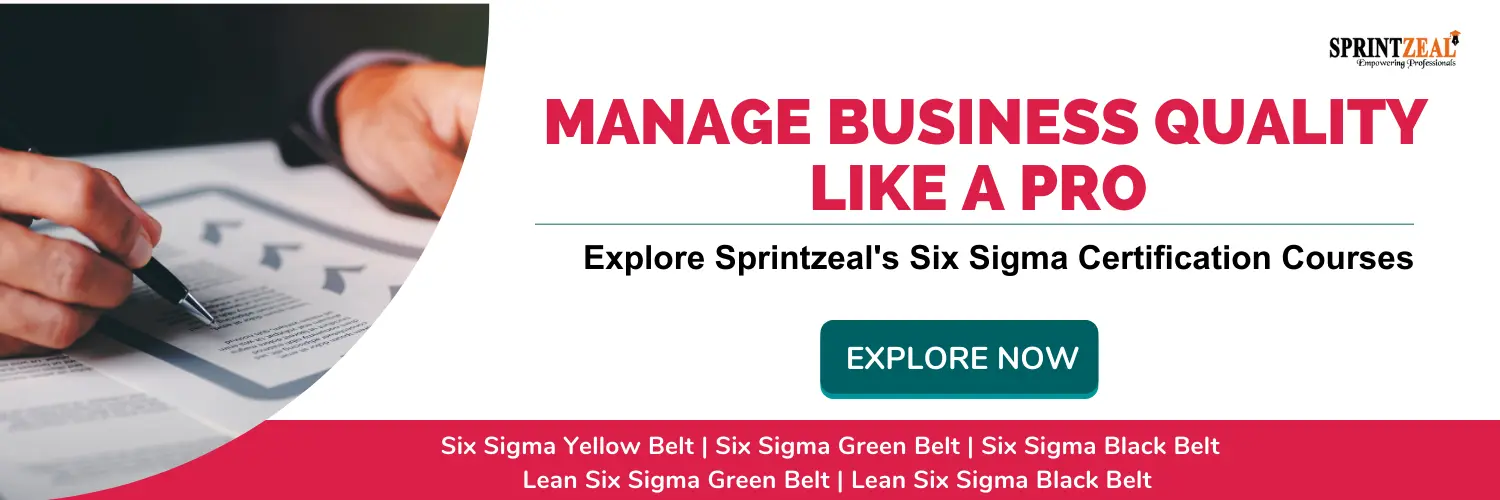The Ultimate Guide to ISO 9001: Boosting Quality and Certification Success
-
 By Afra Noorain
By Afra Noorain - Published on Jul 24 2024

Table of Contents
Introduction to ISO 9001
ISO 9001 is a global Quality standard that specifies the criteria for a quality management system (QMS). Adopting the ISO 9001 standard is crucial, as it provides a universally recognized framework for quality management. In today's competitive business environment, organizations are constantly striving to improve performance, increase customer satisfaction, and foster growth. This Sprintzeal’s detailed guide will serve as a roadmap, guiding organizations from certification to realizing benefits, ensuring quality-driven performance.
ISO 9001 encompasses all the essential elements of a quality management system, outlining requirements for organizations to enhance their quality and satisfaction levels. This international standard provides a consistent framework, regardless of the organization's size, industry, or product line.
What is ISO 9001?
Think of ISO 9001 as a roadmap to quality excellence. It is a globally recognized quality standard that sets up a framework for organizations to deliver top-notch products and services consistently. ISO 9001 does not dictate how to run your business, but rather provides a structure to ensure you are meeting customer needs and regulations. It emphasizes seven core principles, like focusing on customer satisfaction, having strong leadership, and continuously improving your processes.
As a part of the ISO 9000 family, which deals with quality management, ISO 9001:2015 is the latest version that incorporates a more risk-based approach, requiring organizations to consider their operational context. Indeed, the standard applies to any organization, big or small, manufacturing or providing services, and in reducing ways that would lead to an increase in the satisfaction of the customers with quality products.
ISO 9001 Quality Management Benefits
The benefits of ISO 9001 are numerous and can significantly improve different areas of your organization:
- Enhanced Customer Satisfaction
ISO 9001 regards customer satisfaction as one of the primary objectives. By ensuring that the processes to follow are clearly defined and focusing on key principles to manage quality, the organization can ideally grant satisfaction to customers with agreed-to products and services that meet, and at times exceed, their demands and expectations, thereby securing remuneration.
- Improved operational effectiveness
ISO 9001 encourages organizations to make their processes lean, eliminate wastefulness, and reduce their waste. The standard fosters a process-based approach, hence facilitating a way of increasing efficiency in the business in terms of the bottlenecks and opportunities for improvement in operation. This further results in an effective way of improving performance, monetary savings, and resource management.
- Employee engagement and morale
ISO 9001 implementation is ensured by stimulating employees at all working levels to create a culture promoting quality and continuous improvement. Clear roles and responsibilities within the organization will also help improve morality and job satisfaction for employees since training and development will be frequent. Thus, a well-taken-care-of employee in terms of skills and morale will be willing to contribute to the success of an organization.

- Risk Management
The ISO 9001 standard is based on the approach that organizations should support risk-based decisions to identify future issues and mitigate their impacts. Therefore, it allows the business to be more astute in risk management, taking out expensive reactivity to risks that upend business, and focusing on increasing opportunities and resilience for the company.
- Market Opportunities
This will open the doors to a new market opportunity because a majority of the industries and clients request their suppliers to be ISO 9001 certified before they avail of their goods and services—a cool passport for winning contracts that push into new markets. For organizations, it increases reputation and credibility.
To read the benefits in more detail, check out our comprehensive blog on ISO 9001 Standard: Benefits and Certification.
ISO 9001 Implementation Steps
To ensure a smooth and effective implementation of ISO 9001, follow these essential steps:
1. Obtain Senior Management Support: Strong leadership and commitment from top management are crucial for successful implementation.
2. Understand ISO 9001 Requirements: Familiarity with the standard's structure and clauses is essential.
3. Gap Analysis: Identifying existing processes and systems that meet ISO 9001 requirements and areas needing improvement is crucial.
4. Quality Management System (QMS) Implementation: A detailed project plan outlines the scope, timeline, resources, and responsibilities for each phase of the project.
5. Operational Planning and Control: A detailed project plan outlining the scope, timeline, resources, and responsibilities is essential.
6. Monitor and Measure Performance: Internal audits and management reviews are crucial for verifying the QMS's effectiveness.
7. Seek Certification: Once the QMS is fully implemented, seek certification by selecting a certification body, preparing for the audit, and demonstrating compliance.
8. Continual Improvement of QMS: Regular reviews and improvements of processes are necessary to meet customer needs and achieve higher performance.
Read Sprintzeal’s detailed Step-by-step guide on implementing ISO 9001 for your organization.
Success Strategies for ISO 9001 Implementation
Key Strategies for Effective ISO 9001 Implementation
Top Management Commitment
Secure strong commitment and involvement from top management to drive the ISO 9001 implementation process.
Employee Internalization
Encourage employees to take ownership of the QMS by promoting active participation and engagement.
Clear Communication
Effectively convey the significance and advantages of ISO 9001 to all stakeholders to ensure their understanding and support.
Process Approach
Focus on processes and their interactions, treating quality management holistically to improve efficiency and effectiveness.
Continuous Improvement
Instill a culture of continuous improvement in employees, highlighting growth opportunities and the importance of ongoing development.

Solid Leadership
Ensure top management commits to quality, provides clear direction, and supports the QMS, fostering a quality culture within the organization.
Employee Involvement
Engage employees at all levels through consistent communication, feedback, and training, making them accountable and understanding the benefits of the QMS.
Focus on Customer Needs
Center on meeting customer needs and expectations, managing processes to incorporate customer feedback, and quickly addressing complaints to build loyalty.
Monitoring and Continuous Evaluation
Consistently evaluate and review the QMS using performance metrics, internal audits, and management reviews to pinpoint areas for enhancement and implement necessary corrective actions.
Apply Technology
Utilize technology tools to enhance efficiency and effectiveness in documentation, performance tracking, and electronic auditing, improving communication within the organization.
Overcoming Common Challenges
The implementation of ISO 9001 can become a very tedious and complex process to get through. Common challenges include:
- Lack of resources: Insufficient resources, including time, money, and personnel, can hinder implementation.
- Resistance to change: Change often calls for big shifts in an organization, which sets off an alarm for some employees.
- Complexities: The complexity of the ISO 9001 standard can be overwhelming for some organizations.
To overcome these challenges, it is essential to
- Craft a clear implementation plan: Have a clear implementation plan and timeline.
- Training and awareness: Employees must understand the benefits that accrue from ISO 9001 and the requirements.
- Assign responsibilities: there should be clearly defined roles and responsibilities for proper accountability.
ISO 9001 Certification Process
Follow these steps to achieve and maintain ISO 9001 certification for your organization:
1. Pre-Assessment: Before seeking certification, organizations may want to perform a pre-assessment to prove their readiness for certification. It is an advisable step for revealing gaps and making necessary improvements or changes before the proper audit is held.
2. Certification Body Selected: The selection of a certification body is an important part when it comes to an ISO 9001 certification. Choose bodies that are established and preferably have experience with industries.
3. Stage 1 Audit: Stage 1 audit or Documentation Review: The QMS documentation maintained is evaluated against the requirements set by the ISO 9001. The auditor goes through the content of the Quality Manual, procedures, and other documents relevant to establishing its conformance with the requirements of the ISO 9001.
4. Stage 2 Audit: The Stage 2 audit, on the other hand, is also the certification audit. The auditor carries out activities on-site, interviews the staff, and cross-checks the records. His findings form the certification of whether an organization is in the right place to be certified.
5. Addressing Non-Conformities: Action If the audit reveals non-conformities, the organization shall take corrective action to overcome such a finding. It is necessary to revise procedures, update training, or even put new controls into place. Another review by the certification body will be held against the corrective actions being effective.
6. Certification Decision: The ISO 9001 certificate will, therefore, be awarded by the certification body upon the successful conclusion of the Stage 2 audit and after the settlement of the non-conformities. This kind of certificate is awarded for three years and is liable for surveillance audits at different intervals within the said years.
7. Surveillance Audits: The surveillance audits shall be performed annually to monitor UW's QMS to determine continued compliance with the intent of ISO 9001. The audits, by themselves, will review significant processes, performance, key metrics, and the effectiveness of appropriate corrective actions. They lead stakeholders to areas of improvement while making sure the QMS is effective.
8. Re-certification audit: Suppose the closure of the certification period, there is a need for a re-certification audit which will lead to the restoration of the ISO 9001 Certificate. A recertification audit will be performed to inspect a QMS implementation thoroughly, to ensure that it is still in compliance with a respectively applied standard. Recertification therefore shows recommitment of the organization to quality management.
Conclusion
The achievement of ISO certification 9001 is a major step any organization can ever take. This simply means it strives for quality and perfection, ensuring the satisfaction of customers and more efficiency of operation. By following the steps outlined in this guide and adopting the success strategies, organizations can effectively implement and maintain a robust QMS, reaping the numerous benefits that ISO 9001 offers.
By embracing ISO 9001, organizations can not only improve their processes and products but also build a strong foundation for sustained growth and success in an increasingly competitive market.
Looking to advance your expertise in quality management and compliance?
consider enrolling in our specialized ISO courses at Sprintzeal. Our offerings include:
ISO 13485 Foundation,
ISO 45001 Lead Auditor,
ISO/IEC 17025 Lead Implementer, and
ISO/IEC 17025 Lead Assessor and many other. Each course is designed to equip you with the knowledge and skills needed to excel in your field and enhance your professional credentials. Visit our official website and take the next step in your career journey. Please do not hesitate to contact us for more details via call or mail.
Subscribe to our Newsletters
Popular Programs
Trending Posts
Learn about Statistical Process Control (SPC) and its top applications
Last updated on Mar 21 2023
Compliance Manager Interview Questions and Answers 2024
Last updated on Nov 3 2023
Tips for Continuous Integration Testing: Streamlining QA
Last updated on Feb 18 2025
How to become a Quality Analyst
Last updated on Jan 11 2024
Explaining QMS Documentation Structure: Benefits and Best Practices
Last updated on Aug 28 2024
ISO 9001 Standard: Benefits and Certification
Last updated on Dec 11 2024
Categories
- Agile Management 54
- AI and Machine Learning 42
- Big Data 53
- Business Management 51
- Cloud Computing 44
- Digital Marketing 56
- Information Security 8
- IT Hardware and Networking 17
- IT Security 103
- IT Service Management 29
- Leadership and Management 1
- Microsoft Program 2
- Other 43
- Programming Language 31
- Project Management 162
- Quality Management 75
- Risk Management 8
- Workplace Skill Building 2
Trending Now
Top Career benefits of Lean Six Sigma Green Belt
ArticleLean methodology, Six Sigma methodology and Lean Six Sigma Explained
ArticleSix Sigma Black Belt Certification – Value and Career Benefits in 2024
ArticlePareto Chart in Six Sigma - Explained
ArticleQuality Management Interview Questions 2024
ArticleSix Sigma Certification Guide - A Professional's Guide
ArticleSix Sigma Yellow Belt Certification - Six Sigma for Beginners
ArticleQuality Control Explained – Six Sigma
ArticleTotal Quality Management - A Complete Guide for Beginners
ArticleQuality Assurance in Six Sigma Explained
ArticleQuality Assurance vs Quality Control
ArticleSix Sigma Certification – Everything you Need to Know About Getting Certified
ArticleLean Six Sigma on Resume for Rewarding Career Benefits
ArticleQuality Manager Interview Questions and Answers for 2025
ebookService Delivery Manager Interview Questions and Answers (With Examples)
ArticleSix Sigma Interview Questions and Answers 2024
ArticleHow to become a Quality Analyst
ArticleA Supply Chain Management Guide to Mastering Logistics End to End
ArticleSenior Quality Manager Interview Questions and Answers 2024
ArticleTop 30 Quality Analyst Interview Questions and Answers 2025
ArticleFinancial Analyst Interview Questions and Answers 2024
ArticleRisk Manager Interview Questions and Answers 2024
ArticleCompliance Manager Interview Questions and Answers 2024
ArticleOperation Manager Interview Questions and Answers
Article5 Lean Continuous Improvement Principles to Supercharge Your Operations
ArticleHow to Become a Quality Manager - Career, Job Scope and Certifications
ArticleEssential Components of a Quality Management System
ArticleSix Sigma Certifications - Reasons Why you Should Get Them
ArticleTop Qualities of a Good Manager and a Leader
ArticleLearn about Statistical Process Control (SPC) and its top applications
ArticleCost of Poor Quality - A Detailed Guide
ArticleImplementing 5S Methodology for Better Work Efficiency
ArticleWhat Is Lean Management?
ArticleBest Six Sigma Books in 2024
ArticleLeadership vs Management - The Ultimate Guide
ArticleQuality Assurance Plan - Six Steps To Quality Assurance Plan
ArticleOperational Planning Creation, Key Elements and its Benefits
ArticleA Complete Guide to Product Life Cycle Stages 2025
ArticleSix Sigma tools for DMAIC Phases
ArticleWhat Is Lean Manufacturing?- An Overview
ArticleThe Lean Continuous Improvement Model: A Comprehensive Guide
ArticleDMAIC vs. DMADV: Key Differences and Choosing the Right Six Sigma Methodology
ArticleA Deep Dive into the Power of Lean Continuous Improvement Process
ArticleLean Continuous Improvement Methods for Business Excellence
ArticleIntroduction to Lean Manufacturing- Definitions, Framework, and More
ArticleUnderstanding the Key Principles of Lean Manufacturing
ArticleSecret to Unlock Organizational Excellence: Stages of Continuous Improvement
ArticleLean Continuous Improvement: A Detailed Guide to Mastering Organizational Quality
ArticleLean Waste Management: The Ultimate Guide 2023
ArticleA Deep Dive into Lean Continuous Improvement Tools
Article8 Wastes of Lean - Strategies for Identification and Elimination
ArticleThe Ultimate Guide to Lean Manufacturing
ArticleUnderstanding Lean Manufacturing's Pros and Cons
ArticleLean Waste Reduction Strategies: Boost Efficiency and Cut Costs
ArticleTop 10 Lean Manufacturing Tools for Optimal Productivity
ArticleBeyond the Basics: Benefits of Lean Continuous Improvement
ArticleWhat are Quality Standards? | A Guide to ISO Standards
Article7 Important Types of Quality Management System
ArticleA Comprehensive Guide to Quality Management Systems
ArticleISO 9001 Standard: Benefits and Certification
ArticleBenefits of QMS Certification for Your Business
ArticleStep-by-Step Implementation Guide to ISO 9001
ArticleQuality Management System – QSM Approaches and Methodologies
ArticleHow to Effectively Implement a Robust Quality Management System?
ArticleExplaining QMS Documentation Structure: Benefits and Best Practices
ArticleWho Needs ISO 9001 Certification and Why?
ArticleKey Elements of ISO 9001:2015 Quality Management System
ArticleOvercoming Common Challenges in ISO 9001 Certification: Tips and Best Practices
ArticleBest Quality Management Tools
ArticleTotal Quality Management (TQM) vs. Six Sigma
ArticleQuality Manager Salary: What Freshers & Experts Earn in 2025
ArticleCertified Scrum Product Owner: Job Roles And Responsibilities
ArticleTips for Continuous Integration Testing: Streamlining QA
Article10 Quality Management Strategies Adopted by Top Managers
Article


















